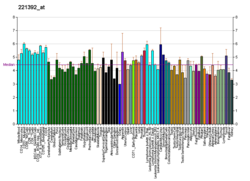미각수용체 2형 멤버 4 는 인간 내 TAS2R4 유전자 에 의해 인코딩 되는 단백질이다.[5] [6] [7]
함수 이 유전자는 G단백질 결합 수용체 슈퍼패밀리의 구성원으로 혀의 미각 수용체 세포와 미각 상피세포에 의해 구체적으로 표현되는 후보 미각 수용체 계열의 구성원을 암호화한 것이다.이 겉보기에는 무내 유전자들은 7-transmembrane 수용체 단백질을 암호화하는 것으로, 쓴맛 수용체 역할을 한다. 이 유전자는 7번 염색체에서 또 다른 3개 후보 미각 수용체 유전자와 군집하고 있으며, 씁쓸한 지각에 영향을 미치는 로키와 유전적으로 연결되어 있다.[7] 수용체 발현을 막는 TAS2R4와 TAS2R5 오감 알레르기의 지리적 분포는 아프리카의 타닌수렴 분포와 파괴적인 농업 조류 병해충 분포와 일치하여, 지역 환경에 맞는 농경 시스템을 개발하는 데 인간의 취향의 역할을 나타낸다.[8]
리간즈 비터DB 에 등재된 리간드에는 퀴닌 , 파르테놀라이드 , 데나토늄 , 수크랄로오스 , 스테비오사이드 등 일부 당분이 함유되지 않은 감미료, 몇 가지 올리고프티드 가 있다.[9]
참고 항목 참조 ^ a b c GRCh38: 앙상블 릴리스 89: ENSG00000127364 - 앙상블 , 2017년 5월^ a b c GRCm38: 앙상블 릴리스 89: ENSMUSG000037140 - 앙상블 , 2017년 5월^ "Human PubMed Reference:" . National Center for Biotechnology Information, U.S. National Library of Medicine .^ "Mouse PubMed Reference:" . National Center for Biotechnology Information, U.S. National Library of Medicine .^ Adler E, Hoon MA, Mueller KL, Chandrashekar J, Ryba NJ, Zuker CS (March 2000). "A novel family of mammalian taste receptors" . Cell . 100 (6): 693–702. doi :10.1016/S0092-8674(00)80705-9 PMID 10761934 . S2CID 14604586 . ^ Chandrashekar J, Mueller KL, Hoon MA, Adler E, Feng L, Guo W, et al. (March 2000). "T2Rs function as bitter taste receptors" . Cell . 100 (6): 703–11. doi :10.1016/S0092-8674(00)80706-0 PMID 10761935 . S2CID 7293493 . ^ a b "Entrez Gene: TAS2R4 taste receptor, type 2, member 4" .^ Wu Y, Guo T, Mu Q, Wang J, Li X, Wu Y, et al. (December 2019). "Allelochemicals targeted to balance competing selections in African agroecosystems" . Nature Plants . 5 (12): 1229–1236. doi :10.1038/s41477-019-0563-0 . PMID 31792396 . S2CID 208539527 . ^ "hTAS2R4 - Taste receptor type 2 member 4" . BitterDB . The Hebrew University of Jerusalem.
추가 읽기 Kinnamon SC (March 2000). "A plethora of taste receptors" . Neuron . 25 (3): 507–10. doi :10.1016/S0896-6273(00)81054-5 PMID 10774719 . Margolskee RF (January 2002). "Molecular mechanisms of bitter and sweet taste transduction" . The Journal of Biological Chemistry . 277 (1): 1–4. doi :10.1074/jbc.R100054200 PMID 11696554 . Montmayeur JP, Matsunami H (August 2002). "Receptors for bitter and sweet taste". Current Opinion in Neurobiology . 12 (4): 366–71. doi :10.1016/S0959-4388(02)00345-8 . PMID 12139982 . S2CID 37807140 . Firestein S (April 2000). "The good taste of genomics" . Nature . 404 (6778): 552–3. doi :10.1038/35007167 PMID 10766221 . S2CID 35741332 . Matsunami H, Montmayeur JP, Buck LB (April 2000). "A family of candidate taste receptors in human and mouse". Nature . 404 (6778): 601–4. Bibcode :2000Natur.404..601M . doi :10.1038/35007072 . PMID 10766242 . S2CID 4336913 . Ueda T, Ugawa S, Ishida Y, Shibata Y, Murakami S, Shimada S (July 2001). "Identification of coding single-nucleotide polymorphisms in human taste receptor genes involving bitter tasting". Biochemical and Biophysical Research Communications . 285 (1): 147–51. doi :10.1006/bbrc.2001.5136 . PMID 11437385 . Zhang Y, Hoon MA, Chandrashekar J, Mueller KL, Cook B, Wu D, et al. (February 2003). "Coding of sweet, bitter, and umami tastes: different receptor cells sharing similar signaling pathways" . Cell . 112 (3): 293–301. doi :10.1016/S0092-8674(03)00071-0 PMID 12581520 . S2CID 718601 . Fischer A, Gilad Y, Man O, Pääbo S (March 2005). "Evolution of bitter taste receptors in humans and apes" . Molecular Biology and Evolution . 22 (3): 432–6. doi :10.1093/molbev/msi027 PMID 15496549 . Go Y, Satta Y, Takenaka O, Takahata N (May 2005). "Lineage-specific loss of function of bitter taste receptor genes in humans and nonhuman primates" . Genetics . 170 (1): 313–26. doi :10.1534/genetics.104.037523 . PMC 1449719 PMID 15744053 . 이 기사는 공공영역 에 있는 미국 국립 의학 도서관 의 텍스트를 통합하고 있다.







